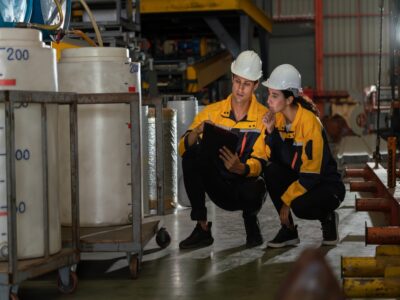Search
Portable Electronic Devices in Hazardous Locations

Yes, this old chestnut!
Manager 1: “It is impossible for the calculator we use in the weigh area to be capable of igniting the dust in there. And then there is the ban we have on use of mobile phones… These things only contain small batteries. They are not like big electric motors, switches or heaters! People carry their mobile phones on gas station forecourts, don’t they?”
Manager 2: “All electrical equipment (which includes all handheld and personal electronic equipment), used in hazardous locations must be suitably rated for each hazardous location.”
So how do we resolve this argument once and for all?
We’d like to invite you to watch a video that we have made and posted on YouTube. Some of you may find this surprising. We made this film in the Stonehouse laboratories just to see what could happen with a battery and a small heap of wood dust.
Photos by Ayaneshu Bhardwaj and John Cameron on Unsplash
Watch video here
If you’ve just watched the video, then you will now be determined to read on and look for a practical conclusion!
Global perspective
Let’s begin by taking a global perspective. Different countries have introduced legislation codes and/or standards that are relevant to the use of personal electronic equipment in hazardous areas. Most is based on national and international standards designed to protect employees and/ or the environment. Individual countries treat level of risk a little differently, but most refer to the risk factors of type of hazard and the probability of its occurrence. As we saw in the other article in this Process Safety Dispatch, in the U.S. (Refs 1,2,3) we use Classes and Divisions and consider the type and probability of occurrence. The European standard uses Zones, which loosely correspond to the Class and Division designations used in the United States.
In the US it is the National Fire Protection Association (NFPA) that determines how “hazardous location” is defined. The International Electrotechnical Commission (IEC) is an international standards organization that prepares and publishes international standards for electrical, electronic, and related technologies.
But in taking a global perspective on the use of personal electronic equipment in Hazardous Locations you quickly find a common approach: Their use in such locations must be suitably rated for each hazardous location. Indeed, if the electrical equipment is not appropriately rated, then it should not be used there.
The Hazards Understood
Here is a look at some potential hazards with the use of mobile phones in Hazardous Locations. We have put this list together from our experience. It is not necessarily an exhaustive list:
- Spontaneous combustion: we all know of certain models of mobile phones that have become so hot that they catch fire. Indeed, our staff have undertaken tests on the batteries of such phones, and there has been a ban on certain phone models by airline companies because of this risk. But would your phone overheat and combust in your pocket, for example? It might when plugged into a mains outlet….. but you will not have any 110V mains outlets on your plant, will you?!
- Electrical spark: mobile phones that are unrated contain batteries which as we have seen in our posted video have more than enough energy content to cause a fire or explosion. The batteries are enclosed inside the phone, but what if the phone becomes wet? Can current escape from the phone?
- Dropping: A dropped electrical devise could shatter exposing its power source. Possibility of a spark? Of course, a dropped phone can also end up inside a piece of process equipment with both electrical and mechanical spark with heat generating capability, but that’s another story.
- Contamination: Could dust or a liquid enter the phone casing and provide a short circuit for the battery? Standard mobile phone cases are not designed and certified to be ‘explosion proof or intrinsically safe.
- Radio Frequency: Any phone will emit radio frequency radiation of variable power. Strong rf signals can induce currents in adjacent metalwork that can lead to sparking, but it is not certain if the power of a mobile phone is sufficient to ignite all flammable atmospheres from such sparking.
- Distraction: May be not a direct electrical ignition risk here but is it always safe for your employees to receive distracting phone calls while working in a hazardous location?
What does science and research tell us about the issue?
First of all, we know there is a small theoretical risk of fire or explosion as a result of the above hazards list. Researchers have tested some of these and estimated probabilities. One such example is found at reference 5. It seems like the risk of 1X106 is a probability that is quoted (i.e., one in a million).
A trawl of the internet reveals cases when portable electronic equipment have both ‘definitely’ and has ‘definitely not’ caused fires and explosions. These cases are not necessarily solid, however, and we invite readers to submit references for examples that have been thoroughly investigated and have resulted in published, peer reviewed accounts.
The Solution
We have to conclude that there is a risk, all be it small, that portable electronic equipment can initiate a fire or explosion in a Hazardous Location. This risk may result from the device’s electrical power source, but it may just as easily relate to dropping and distraction. And there is the litigious reason why you may wish to not allow portable electronic equipment on to your plant. Regulations and codes exist in most jurisdictions around the globe that seek to control the use of such equipment in Hazardous Locations. It would be a brave manager that decided to ignore their national standards and industry guidelines.
So, we suggest, for prudent management, follow these basic rules:
- All electronic or electrical equipment brought into a hazardous area should be appropriately rated for the hazard.
- You may have a company policy that prohibits the use of non-rated equipment within hazardous areas, unless a suitable hot work permit is in operation with flammable atmospheres monitored.
- Your policy should prohibit your employees from bringing their own portable electronic equipment into hazardous areas.
But don’t forget,
- Plant can sometimes be rearranged to create non-hazardous areas, and it may sometimes be possible to reduce the extent of a division/zone with design, layout, physical barriers or ventilation.
- There may be ways of modifying the classified areas you have on plant to accommodate non-rated electrical equipment. For example, operation of a calculator or other small equipment in a specially constructed enclosure designed to keep a flammable atmosphere out.
References
- NFPA70, National Electric Code
- NFPA 497, Classification of Flammable Liquids, Gases, or Vapors and of Hazardous (Classified) Locations for Electrical Installations in Chemical Process Areas
- NFPA 499, Classification of Combustible Dusts and of Hazardous (Classified) Locations for Electrical Installations in Chemical Process Areas
- American Institute of Petroleum RP 500 and RP505.
- 2006 Record of Conference Papers – IEEE Industry Applications Society 53rd Annual Petroleum and Chemical Industry Conference: Cellular Phones in Class I, Division 2/Zone 2 Hazardous Locations: Bozek et al

Get in touch
To learn more about our expertise and services in dust explosion prevention & mitigation, call us at +1 609 455 0001 or email us at [email protected] today.
We also offer tailored virtual and in-company process safety training programs on Dust Explosions, Static Electricity and HAC (Hazardous Area Classification) and more. Find further information here.









